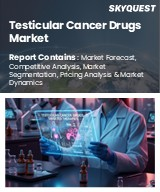
|
시장보고서
상품코드
1447058
저분자 표적 암 치료 시장 예측(-2030년) : 유형별, 용도별, 지역별 세계 분석Small Molecule Targeted Cancer Therapy Market Forecasts to 2030 - Global Analysis By Type, Application and By Geography |
||||||
Stratistics MRC에 따르면, 세계 저분자 표적 암 치료 시장은 2023년 825억 달러 규모이며, 예측 기간 동안 8.7%의 CAGR로 성장하여 2030년에는 1,479억 달러에 달할 것으로 예상됩니다.
저분자 의약품은 고분자 의약품보다 세포 내 침투가 용이하고, 암세포 생존에 필수적인 단백질과 효소의 활성을 효과적으로 억제할 수 있습니다.
저분자 의약품은 저분자를 사용하여 암세포를 표적으로 삼아 암세포의 증식을 억제하도록 특별히 고안된 의약품의 개발 및 상용화를 전문으로 하는 제약 업계의 한 분야입니다. 이러한 치료법은 암의 성장, 진행 및 전이에 관여하는 특정 분자를 억제함으로써 작용하며, 기존 화학요법에 비해 보다 정밀하고 표적화된 치료법을 제공합니다.
FDA에 따르면 세툭시맙과 같은 단클론항체의 반감기(3.1-7.8일)는 게피티닙과 같은 저분자 약물의 반감기(48시간)보다 훨씬 더 깁니다.
암 발병률의 증가
다양한 인구 통계와 지역에 걸쳐 암 발병률이 증가함에 따라 효과적인 치료 옵션에 대한 수요가 증가하고 있습니다. 저분자 표적 치료제는 암세포의 분자적 변화를 특이적으로 표적화하여 암세포의 증식을 억제하거나 건강한 세포에 대한 피해를 최소화하면서 세포 사멸을 유도하는 유망한 암 치료 수단을 제공합니다. 또한, 화학요법과 같은 전통적인 치료법은 종종 부작용을 동반하는 경우가 많기 때문에 보다 표적화된 저독성 치료법에 대한 수요가 증가하고 있습니다.
높은 개발 비용
특정 암세포를 표적으로 하는 저분자 의약품을 개발하기 위해서는 대규모 연구, 임상시험, 규제 당국의 승인이 필요하며, 이 모든 과정에는 많은 비용이 소요됩니다. 적절한 분자 표적을 식별하고, 화합물을 설계하고, 효능을 최적화하고, 안전성을 보장하는 복잡한 과정은 막대한 재정적 투자를 필요로 합니다. 그러나 엄격한 규제 요건과 긴 승인 일정은 전체 개발 비용을 더욱 증가시킵니다. 자금력이 부족한 중소 생명공학기업과 신생기업에게 이러한 높은 비용은 시장 진입에 큰 장벽이 될 수 있습니다.
기술의 발전
고처리량 스크리닝, 분자 모델링, 계산 화학 등의 첨단 기술은 암 표적에 대한 특이성과 효능이 높은 저분자를 식별하고 설계할 수 있게 해줍니다. 분석 기술의 발전은 약물 후보물질의 정확한 특성화를 용이하게 하고, 약동학적 및 약력학적 특성을 최적화합니다. 또한, 나노기술과 표적 약물전달을 포함한 약물전달 시스템의 혁신은 종양 침투를 개선하고 표적 외 영향을 줄임으로써 저분자 의약품의 치료 지수를 향상시키고 있습니다.
제한된 바이오마커
생물학적 과정이나 치료 반응에 대한 측정 가능한 지표인 바이오마커는 표적치료에 적합한 환자를 식별하는 데 중요한 역할을 합니다. 특정 암이나 표적치료제에 특화된 바이오마커의 가용성은 종종 제한적입니다. 이러한 한계는 저분자 표적치료제가 가장 효과적인 환자를 정확하게 선택하지 못하게 하고, 최적의 치료 결과를 얻지 못하여 시장 성장을 제한할 수 있습니다. 따라서 바이오마커의 부족은 암 표적 치료제의 효능을 제한하고, 치료 대상 환자 수를 감소시킴으로써 시장 성장을 저해할 수 있습니다.
COVID-19의 영향:
의료 서비스 및 자원의 혼란으로 인해 암 치료에 대한 관심과 자원이 분산되어 진단 및 치료 시작이 지연되고 있습니다. 새로운 저분자 표적 치료제의 임상시험이 중단되거나 연기되어 신약 개발 및 승인에 장애가 되었습니다. 공급망의 혼란과 이동 제한은 기존 치료제의 생산과 유통에 더욱 영향을 미쳐 부족과 환자 치료 접근 지연을 초래했습니다. 그러나 의료 시스템과 환자에 대한 재정적 부담도 이러한 치료법의 구매 가능성과 이용률에 영향을 미쳤습니다.
예측 기간 동안 티로신 키나아제 억제제 부문이 가장 큰 시장으로 성장할 것으로 예상
티로신 키나아제 억제제는 독특한 작용 기전과 다양한 유형의 암에 대한 효과로 인해 예측 기간 동안 가장 큰 시장을 형성할 것으로 예상됩니다. 이들 억제제는 암세포의 성장과 증식에 관여하는 신호 전달 경로에서 중요한 역할을 하는 효소인 특정 티로신 키나아제를 표적으로 삼기 때문에 티로신 키나아제 억제제 부문은 예측 기간 동안 가장 큰 점유율을 차지할 것으로 예상됩니다. 티로신 키나아제 억제제의 정밀한 타겟팅은 건강한 세포에 대한 손상을 최소화하여 기존 화학 요법에 비해 부작용이 적습니다. 또한, 효능이 개선되고 독성 프로파일이 감소된 새로운 TKI의 시장 개척은 다양한 유형의 암 환자를 위한 치료 옵션을 확대하여 시장 성장을 더욱 촉진하고 있습니다.
예측 기간 동안 흑색종 분야가 가장 높은 CAGR을 보일 것으로 예상
흑색종 분야는 예측 기간 동안 큰 성장을 이룰 것으로 예상됩니다. 피부암의 일종인 흑색종은 전 세계적으로 발병률이 크게 증가하면서 효과적인 치료법에 대한 수요가 증가하고 있습니다. 저분자 표적 치료는 암의 증식과 진행에 관여하는 분자를 특이적으로 표적화하여 흑색종 치료의 정확성을 높이고, 기존 치료법에 비해 효능을 향상시키고 부작용을 감소시킵니다. 또한, 연구의 발전으로 흑색종에 관여하는 특정 유전자 돌연변이 및 경로를 표적으로 하는 새로운 저분자 약물이 개발되어 환자가 이용할 수 있는 치료 옵션이 확대되고 있습니다. 이러한 요소들이 이 부문의 성장을 촉진하고 있습니다.
가장 높은 점유율을 차지하는 지역:
개인맞춤형 의료로 인식되고 있는 암 치료는 환자별 분자 프로파일에 따라 맞춤화되는 추세에 따라 아시아태평양이 예측 기간 동안 가장 큰 시장 점유율을 차지할 것으로 예상됩니다. 암 환자에서 특정 저분자를 표적으로 삼는 것은 개별 환자의 특수성을 고려하여 보다 개인화되고 정확한 치료 계획을 세울 수 있게 해줄 수 있습니다. 게놈 시퀀싱 기술이 발전함에 따라 특정 암과 관련된 희귀한 유전자 이상이나 바이오마커를 찾는 것이 더 쉬워질 것입니다. 또한, 제약회사는 이 분야의 풍부한 유전자 데이터를 통해 특정 유전자 프로파일과 관련된 고도로 표적화된 약물을 개발하여 치료 효과와 정확성을 향상시킬 수 있습니다.
CAGR이 가장 높은 지역:
아시아태평양은 의료진이 암 치료에서 표적 치료의 이점과 효과에 대한 지식이 높아짐에 따라 환자들에게 표적 치료제를 추천할 가능성이 높아짐에 따라 예측 기간 동안 수익성 있는 성장을 이룰 것으로 예상됩니다. 이러한 인식은 건강한 세포에 대한 손상을 최소화하면서 암세포를 특이적으로 표적화하도록 설계된 저분자 표적 치료제의 채택을 확대할 것으로 예상됩니다. 또한, 이 지역의 의료 서비스 제공자들은 표적 치료제를 뒷받침하는 최신 발전과 임상적 증거를 지속적으로 파악함으로써 이러한 치료에 적합한 환자를 식별하고 개별 환자의 필요에 맞게 치료 요법을 조정할 수 있는 능력이 향상되고 있습니다.
무료 맞춤형 서비스:
이 보고서를 구독하는 고객은 다음과 같은 무료 맞춤화 옵션 중 하나를 사용할 수 있습니다:
- 기업 개요
- 추가 시장 기업의 종합적인 프로파일링(최대 3개사까지)
- 주요 기업 SWOT 분석(최대 3개사)
- 지역 세분화
- 고객의 관심에 따른 주요 국가별 시장 추정치, 예측, CAGR(주: 타당성 검토에 따른)
- 경쟁사 벤치마킹
- 제품 포트폴리오, 지리적 입지, 전략적 제휴를 기반으로 한 주요 기업 벤치마킹
목차
제1장 주요 요약
제2장 서문
- 개요
- 이해관계자
- 조사 범위
- 조사 방법
- 데이터 마이닝
- 데이터 분석
- 데이터 검증
- 조사 접근법
- 조사 소스
- 1차 조사 소스
- 2차 조사 소스
- 가정
제3장 시장 동향 분석
- 성장 촉진요인
- 성장 억제요인
- 기회
- 위협
- 용도 분석
- 신흥 시장
- 신종 코로나바이러스 감염증(COVID-19)의 영향
제4장 Porter's Five Forces 분석
- 공급 기업의 교섭력
- 구매자의 교섭력
- 대체품의 위협
- 신규 참여업체의 위협
- 경쟁 기업 간의 경쟁 관계
제5장 세계의 저분자 표적 암 치료 시장 : 유형별
- 티로신 키나아제 억제제
- 저분자 약물 복합체
- 기타 유형
제6장 세계의 저분자 표적 암 치료 시장 : 용도별
- 유방암
- 다발성 골수종
- 흑색종
- 림프종
- 전립선암
- 기타 용도
제7장 세계의 저분자 표적 암 치료 시장 : 지역별
- 북미
- 미국
- 캐나다
- 멕시코
- 유럽
- 독일
- 영국
- 이탈리아
- 프랑스
- 스페인
- 기타 유럽
- 아시아태평양
- 일본
- 중국
- 인도
- 호주
- 뉴질랜드
- 한국
- 기타 아시아태평양
- 남미
- 아르헨티나
- 브라질
- 칠레
- 기타 남미
- 중동 및 아프리카
- 사우디아라비아
- 아랍에미리트
- 카타르
- 남아프리카공화국
- 기타 중동 및 아프리카
제8장 주요 발전
- 계약, 파트너십, 협업, 합작투자
- 인수와 합병
- 신제품 발매
- 사업 확대
- 기타 주요 전략
제9장 기업 개요
- Abbott Laboratories
- Amgen
- AstraZeneca
- Bayer HealthCare AG
- Boehringer Ingelheim GmbH
- Bristol-Myers Squibb
- Cytokinetics Inc
- Genentech
- GlaxoSmithKline plc
- Hospira Inc
- Novartis
According to Stratistics MRC, the Global Small Molecule Targeted Cancer Therapy Market is accounted for $82.5 billion in 2023 and is expected to reach $147.9 billion by 2030 growing at a CAGR of 8.7% during the forecast period. Small molecule drugs can penetrate cells more easily than larger molecules, allowing them to effectively inhibit the activity of proteins and enzymes critical for cancer cell survival.
It refers to the segment of the pharmaceutical industry dedicated to developing and commercializing drugs specifically designed to target and inhibit the growth of cancer cells through small molecules. These therapies work by interfering with specific molecules involved in the growth, progression, and spread of cancer, thereby offering more precise and targeted treatment options compared to traditional chemotherapy.
According to the FDA, the half life of monoclonal antibodies like cetuximab (3.1-7.8 days) is much longer than those of small-molecule agents like gefitinib (48 hours).
Market Dynamics:
Driver:
Increasing incidence of cancer
With cancer rates on the rise across various demographics and geographies, there is a growing demand for effective treatment options. Small molecule targeted therapies offer promising avenues for cancer treatment by specifically targeting molecular alterations in cancer cells, thereby inhibiting their growth or inducing cell death with minimal harm to healthy cells. Additionally, as traditional treatments like chemotherapy often come with debilitating side effects, the demand for more targeted and less toxic therapies is increasing.
Restraint:
High development costs
Developing small molecule drugs tailored to target specific cancer cells involves extensive research, clinical trials, and regulatory approvals, all of which incur substantial expenses. The intricate process of identifying suitable molecular targets, designing compounds, optimizing their efficacy, and ensuring their safety demands substantial financial investments. However, the rigorous regulatory requirements and lengthy approval timelines further escalate the overall development costs. For smaller biotechnology companies or startups with limited financial resources, these high costs present a considerable barrier to entry into the market.
Opportunity:
Technological advancements
Cutting-edge technologies such as high-throughput screening, molecular modeling, and computational chemistry enable the identification and design of small molecules with enhanced specificity and efficacy against cancer targets. Advances in analytical techniques facilitate the precise characterization of drug candidates, optimizing their pharmacokinetic and pharmacodynamic properties. Moreover, innovations in drug delivery systems, including nanotechnology and targeted drug delivery, enhance the therapeutic index of small molecule drugs by improving their tumor penetration and reducing off-target effects.
Threat:
Limited biomarkers
Biomarkers, which are measurable indicators of biological processes or responses to treatment, play a crucial role in identifying suitable patients for targeted therapies. The availability of biomarkers specific to certain types of cancer or targeted therapies is often limited. This limitation hampers the precise selection of patients who would benefit most from small molecule targeted therapies, leading to suboptimal treatment outcomes and potentially limiting market growth. Therefore, the lack of biomarkers limits the efficacy of targeted cancer medicines and also prevents market growth by reducing the number of patients that are eligible for these treatments.
Covid-19 Impact:
Disruptions in healthcare services and resources diverted attention and resources away from cancer treatment, leading to delays in diagnosis and initiation of therapy. Clinical trials for new small molecule targeted therapies faced interruptions or postponements, hindering the development and approval of new drugs. Supply chain disruptions and restrictions on movement further affected the manufacturing and distribution of existing therapies, causing shortages and delays in treatment access for patients. However, financial strains on healthcare systems and patients also impacted the affordability and utilization of these therapies.
The tyrosine kinase inhibitors segment is expected to be the largest during the forecast period
Due to their unique mechanism of action and effectiveness in treating various types of cancers. These inhibitors target specific tyrosine kinases, which are enzymes that play a crucial role in the signaling pathways involved in cancer cell growth and proliferation, Tyrosine Kinase Inhibitors segment is expected to hold the largest share during the projection period. Their precision targeting minimizes damage to healthy cells, leading to fewer adverse effects compared to traditional chemotherapy. Additionally, the development of novel TKIs with improved efficacy and reduced toxicity profiles has expanded treatment options for patients with different types of cancers, further driving market growth.
The melanoma segment is expected to have the highest CAGR during the forecast period
Melanoma segment is estimated to have the considerable growth over the forecast period. Melanoma, a type of skin cancer, has seen a substantial rise in incidence globally, driving the demand for effective treatments. Small molecule targeted therapies offer precision in combating melanoma by specifically targeting molecules involved in cancer growth and progression, resulting in enhanced efficacy and reduced side effects compared to traditional treatments. Additionally, advancements in research have led to the development of novel small molecule drugs tailored to target specific genetic mutations and pathways implicated in melanoma, expanding the therapeutic options available to patients. These elements are enhancing the segmental growth.
Region with largest share:
Because treatments for cancer are increasingly being customized to a patient's unique molecular profile, a phenomenon recognized as personalized medicine, the Asia Pacific region is expected to hold the largest share of the market during the projected period. Targeting specific small molecules in cancer patients may allow for more individualized and accurate treatment plans that take into account the particulars of their individual cases. As genome sequencing technology develops, it becomes simpler to find uncommon genetic anomalies and biomarkers connected to certain cancers. Furthermore, pharmaceutical companies can create highly targeted medications that are linked to certain genetic profiles due to the wealth of genetic data available in the area, improving treatment efficacy and precision.
Region with highest CAGR:
As healthcare providers become more knowledgeable about the benefits and effectiveness of targeted therapy in cancer treatment, they are more likely to recommend it to their patients, Asia Pacific region is estimated to witness profitable growth throughout the extrapolated period. This awareness leads to greater adoption of small molecule targeted therapies, which are designed to specifically target cancer cells while minimizing damage to healthy cells. Additionally, as healthcare providers in the region stay updated on the latest advancements and clinical evidence supporting targeted therapies, they become better equipped to identify suitable patients for these treatments and tailor therapy regimens to individual needs.
Key players in the market
Some of the key players in Small Molecule Targeted Cancer Therapy market include Abbott Laboratories, Amgen, AstraZeneca, Bayer HealthCare AG, Boehringer Ingelheim GmbH, Bristol-Myers Squibb, Cytokinetics Inc, Genentech, GlaxoSmithKline plc, Hospira Inc and Novartis.
Key Developments:
In February 2024, Novartis to acquire cancer-centric MorphoSys for $2.9 bln. Novartis will offer shareholders 68.00 euros per share in cash and take MorphoSys private after the deal, which is contingent on certain conditions, including a minimum acceptance threshold of 65% of MorphoSys' share capital and regulatory clearances.
In February 2024, Erasca, Inc., a precision oncology company, has entered into clinical trial collaboration and supply agreements with pharmaceutical giant Novartis to advance the development of a new cancer treatment.
Types Covered:
- Tyrosine Kinase Inhibitors
- Small Molecule Drug Conjugates
- Other Types
Applications Covered:
- Breast Cancer
- Multiple Myeloma
- Melanoma
- Lymphoma
- Prostate Cancer
- Other Applications
Regions Covered:
- North America
- US
- Canada
- Mexico
- Europe
- Germany
- UK
- Italy
- France
- Spain
- Rest of Europe
- Asia Pacific
- Japan
- China
- India
- Australia
- New Zealand
- South Korea
- Rest of Asia Pacific
- South America
- Argentina
- Brazil
- Chile
- Rest of South America
- Middle East & Africa
- Saudi Arabia
- UAE
- Qatar
- South Africa
- Rest of Middle East & Africa
What our report offers:
- Market share assessments for the regional and country-level segments
- Strategic recommendations for the new entrants
- Covers Market data for the years 2021, 2022, 2023, 2026, and 2030
- Market Trends (Drivers, Constraints, Opportunities, Threats, Challenges, Investment Opportunities, and recommendations)
- Strategic recommendations in key business segments based on the market estimations
- Competitive landscaping mapping the key common trends
- Company profiling with detailed strategies, financials, and recent developments
- Supply chain trends mapping the latest technological advancements
Free Customization Offerings:
All the customers of this report will be entitled to receive one of the following free customization options:
- Company Profiling
- Comprehensive profiling of additional market players (up to 3)
- SWOT Analysis of key players (up to 3)
- Regional Segmentation
- Market estimations, Forecasts and CAGR of any prominent country as per the client's interest (Note: Depends on feasibility check)
- Competitive Benchmarking
- Benchmarking of key players based on product portfolio, geographical presence, and strategic alliances
Table of Contents
1 Executive Summary
2 Preface
- 2.1 Abstract
- 2.2 Stake Holders
- 2.3 Research Scope
- 2.4 Research Methodology
- 2.4.1 Data Mining
- 2.4.2 Data Analysis
- 2.4.3 Data Validation
- 2.4.4 Research Approach
- 2.5 Research Sources
- 2.5.1 Primary Research Sources
- 2.5.2 Secondary Research Sources
- 2.5.3 Assumptions
3 Market Trend Analysis
- 3.1 Introduction
- 3.2 Drivers
- 3.3 Restraints
- 3.4 Opportunities
- 3.5 Threats
- 3.6 Application Analysis
- 3.7 Emerging Markets
- 3.8 Impact of Covid-19
4 Porters Five Force Analysis
- 4.1 Bargaining power of suppliers
- 4.2 Bargaining power of buyers
- 4.3 Threat of substitutes
- 4.4 Threat of new entrants
- 4.5 Competitive rivalry
5 Global Small Molecule Targeted Cancer Therapy Market, By Type
- 5.1 Introduction
- 5.2 Tyrosine Kinase Inhibitors
- 5.3 Small Molecule Drug Conjugates
- 5.4 Other Types
6 Global Small Molecule Targeted Cancer Therapy Market, By Application
- 6.1 Introduction
- 6.2 Breast Cancer
- 6.3 Multiple Myeloma
- 6.4 Melanoma
- 6.5 Lymphoma
- 6.6 Prostate Cancer
- 6.7 Other Applications
7 Global Small Molecule Targeted Cancer Therapy Market, By Geography
- 7.1 Introduction
- 7.2 North America
- 7.2.1 US
- 7.2.2 Canada
- 7.2.3 Mexico
- 7.3 Europe
- 7.3.1 Germany
- 7.3.2 UK
- 7.3.3 Italy
- 7.3.4 France
- 7.3.5 Spain
- 7.3.6 Rest of Europe
- 7.4 Asia Pacific
- 7.4.1 Japan
- 7.4.2 China
- 7.4.3 India
- 7.4.4 Australia
- 7.4.5 New Zealand
- 7.4.6 South Korea
- 7.4.7 Rest of Asia Pacific
- 7.5 South America
- 7.5.1 Argentina
- 7.5.2 Brazil
- 7.5.3 Chile
- 7.5.4 Rest of South America
- 7.6 Middle East & Africa
- 7.6.1 Saudi Arabia
- 7.6.2 UAE
- 7.6.3 Qatar
- 7.6.4 South Africa
- 7.6.5 Rest of Middle East & Africa
8 Key Developments
- 8.1 Agreements, Partnerships, Collaborations and Joint Ventures
- 8.2 Acquisitions & Mergers
- 8.3 New Product Launch
- 8.4 Expansions
- 8.5 Other Key Strategies
9 Company Profiling
- 9.1 Abbott Laboratories
- 9.2 Amgen
- 9.3 AstraZeneca
- 9.4 Bayer HealthCare AG
- 9.5 Boehringer Ingelheim GmbH
- 9.6 Bristol-Myers Squibb
- 9.7 Cytokinetics Inc
- 9.8 Genentech
- 9.9 GlaxoSmithKline plc
- 9.10 Hospira Inc
- 9.11 Novartis



















